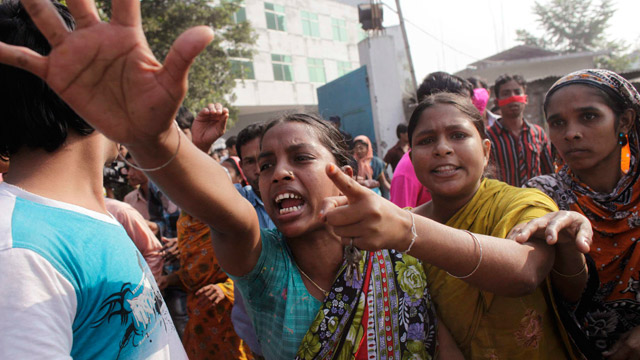
On May 10, 1993, 188 workers died, or were killed, in a fire at the Kader Toy Factory, in Bangkok, Thailand. 177 of the killed workers were women. The factory had no fire alarms, no sprinklers, very few fire extinguishers, and practically no means of escape. Those not immediately burned to death jumped out of third and fourth story windows … and were killed or seriously injured.
On November 19, 1993, 87 workers, all women, died, or were killed, in a fire at the Zhili Handicraft Factory, in Shenzhen, China’s first Special Economic Zone. A month later, on December 13, 61 women workers died, or were killed, in a fire at the Gaofu Textile Factory, in Fuzhou.
On Sunday, November 25, 2012, Bangladesh suffered its worst-ever factory fire, at the Tazreen Fashions factory, one of 4500 garment factories in the country. At last count, 123 workers died. By all accounts, the workers were all or almost all women.
Nothing here is new. Industries rely on women’s `nimble fingers’ to produce goods. Factories filled with women are overcrowded, have no fire alarms or sprinklers, and have no means of escape. Many women are burned to death. In these more recent versions, as in the earlier Triangle Shirtwaist Factory fire, the factories are the signature of the modern. They are proof positive of progress made, or so the public is told.
Until the fire next time.
And each time, the fire, the tragedy, `enlightens’ a public that was previously innocent of any knowledge of the circumstances of industrial women workers. Fortunately for the innocent public, the dead cannot speak, cannot contradict the protestations of surprise and the performances of dismay.
But the living can.
At almost the same time the Tazreen factory burst into flames, garment workers, women workers, gathered in Bengaluru, in India, to give testimony to their working lives and to make demands. Managers abuse the women verbally and physically. The production targets are impossible. The pay is bare. The list goes on. What do the women want? They want what every worker wants. They want dignity, they want a living wage, they want the right to organize. They want everything that constitutes dignity, they want everything that expands dignity.
The women know they are working in a factory that is all women workers because a factory full of women is a factory of low wages. They are told this is a sign of development, of modernity. The women know better.
As we enter into the 16 Days of Activism Against Gender Violence, mourn the women workers who have died in the fires and support the women workers who continue to organize and make demands, as they produce clothing, toys, microchips, textiles, and more. Don’t let the brilliance of the fire obscure the urgencies of women workers’ everyday struggles for dignity and a living wage.
(Photo Credit: The Guardian)